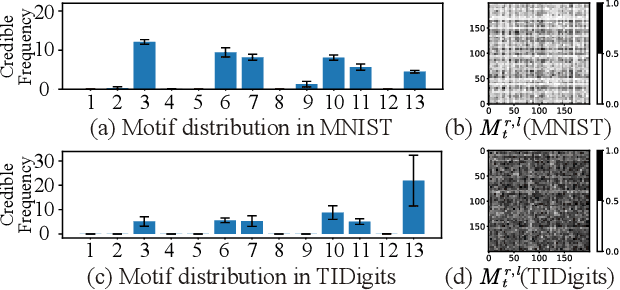Ruichen Zuo
Motif-topology improved Spiking Neural Network for the Cocktail Party Effect and McGurk Effect
Nov 12, 2022Abstract:Network architectures and learning principles are playing key in forming complex functions in artificial neural networks (ANNs) and spiking neural networks (SNNs). SNNs are considered the new-generation artificial networks by incorporating more biological features than ANNs, including dynamic spiking neurons, functionally specified architectures, and efficient learning paradigms. Network architectures are also considered embodying the function of the network. Here, we propose a Motif-topology improved SNN (M-SNN) for the efficient multi-sensory integration and cognitive phenomenon simulations. The cognitive phenomenon simulation we simulated includes the cocktail party effect and McGurk effect, which are discussed by many researchers. Our M-SNN constituted by the meta operator called network motifs. The source of 3-node network motifs topology from artificial one pre-learned from the spatial or temporal dataset. In the single-sensory classification task, the results showed the accuracy of M-SNN using network motif topologies was higher than the pure feedforward network topology without using them. In the multi-sensory integration task, the performance of M-SNN using artificial network motif was better than the state-of-the-art SNN using BRP (biologically-plausible reward propagation). Furthermore, the M-SNN could better simulate the cocktail party effect and McGurk effect with lower computational cost. We think the artificial network motifs could be considered as some prior knowledge that would contribute to the multi-sensory integration of SNNs and provide more benefits for simulating the cognitive phenomenon.
Motif-topology and Reward-learning improved Spiking Neural Network for Efficient Multi-sensory Integration
Feb 11, 2022



Abstract:Network architectures and learning principles are key in forming complex functions in artificial neural networks (ANNs) and spiking neural networks (SNNs). SNNs are considered the new-generation artificial networks by incorporating more biological features than ANNs, including dynamic spiking neurons, functionally specified architectures, and efficient learning paradigms. In this paper, we propose a Motif-topology and Reward-learning improved SNN (MR-SNN) for efficient multi-sensory integration. MR-SNN contains 13 types of 3-node Motif topologies which are first extracted from independent single-sensory learning paradigms and then integrated for multi-sensory classification. The experimental results showed higher accuracy and stronger robustness of the proposed MR-SNN than other conventional SNNs without using Motifs. Furthermore, the proposed reward learning paradigm was biologically plausible and can better explain the cognitive McGurk effect caused by incongruent visual and auditory sensory signals.
 Add to Chrome
Add to Chrome Add to Firefox
Add to Firefox Add to Edge
Add to Edge